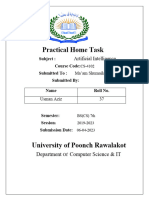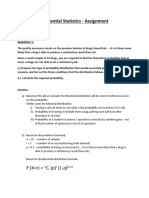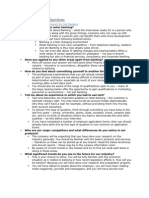Probability and Decision Trees
Probability and Decision Trees
Uploaded by
rubbydeanCopyright:
Available Formats
Probability and Decision Trees
Probability and Decision Trees
Uploaded by
rubbydeanOriginal Description:
Copyright
Available Formats
Share this document
Did you find this document useful?
Is this content inappropriate?
Copyright:
Available Formats
Probability and Decision Trees
Probability and Decision Trees
Uploaded by
rubbydeanCopyright:
Available Formats
1
Probability theory and Probability theory and
Decision trees Decision trees
Probability Probability
Thequantificationof uncertainty The quantification of uncertainty
Uncertainty may also be expressed as
likelihood,chance or risk.
Probability is expressed by p and can only
takes values ranging from 0,ie impossibility, g g , p y,
to 1, ie certainty.
2
Objective and subjective Objective and subjective
probability probability
Objective probability
wheretheprobability
Subjective probability
where a probability value
where the probability
of an event is based on
past data and the
circumstances are
repeatable by test.
Eg. The probability of
tossingacoinanda
p y
cannot be tested by repeated
trials.
The quantification is based
on personal judgement,
experience and expertise.
Eg. a QS considers that
there is 75% chance of
tossing a coin and a
head showing is 50%
or 1/2 or 0.5.
winning a tender for which
his firm has just entered
Basic rules of probability Basic rules of probability
Multiplicationrule
Eg. What is the
Multiplication rule
(AND)
This rule is used when
there is a string of
independent events for
which each individual
probabilit iskno n
g
probability of throwing
a 3 AND a 6 with two
throws of a die?
p(throwing a 3) =1/6
p(throwing a 6) =1/6
probability is known
and it is required to
know the overall
probability
p(throwing a 3 AND a 6)
=1/6 x 1/6
=1/36
3
Basic rules of probability Basic rules of probability
Additionrule(OR)
Eg. What is the
Addition rule (OR)
This rule is used to
calculate the
probability of two or
more mutually
exclusive events. In
suchcircumstancesthe
g
probability of throwing
a 3 OR a 6 with a throw
of a die?
p(throwing a 3) =1/6
p(throwing a 6) =1/6
such circumstances the
probabilities of the
separate events must be
added.
p(throwing a 3 OR a 6)
=1/6 +1/6
=1/3
Basic rules of probability Basic rules of probability
Conditional probability
Thisisaprobabilityassociatedwithcombinationsof This is a probability associated with combinations of
events but given that some prior result has already been
achieved with one of them.
When the events are independent of one another, then
the conditional probability is the same as the probability
of the remaining event
usuallyexpressedintheform: p(x|y) whichmeans usually expressed in the form: p (x|y) which means -
probability of x given that y has occurred
4
Basic rules of probability Basic rules of probability
Eg. The probability of throwing a total of 10 with 2
dice, before the events, is 1/12; , , ;
ie. p(5 and 5) =1/6 x 1/6 =1/36
p(6 and 4) =1/6 x 1/6 =1/36
p(4 and 6) =1/6 x 1/6 =1/36
=3/36
=1/12
but if one of the die has been thrown and shows a 4
then the conditional probability is the probability of
throwing a 6 with the other die, which the probability
is 1/6
Example Example
Formpast experienceit isknownthat amachineis Form past experience it is known that a machine is
set up correctly on 90% of the occasions. If the
machine is set up correctly then 95% of good
products are expected but if the machine is not set
up correctly then the probability of a good product
is only 30%. On a particular day the machine is set y p y
up and the first product was found to be good.
What is the probability that the machine is set up
correctly?
5
Solution Solution
Probability tree
CSGP = 0.9 x 0.95 =0.855
CSBP = 0.9 x 0.05 =0.045
ISGP = 0.1 x 0.3 =0.03
CS =0.9
IS=01
GP =0.3
GP =0.95
BP=0.05
ISBP = 0.1 x 0.7 =0.07
IS =0.1
BP=0.7
Solution Solution
Probability of getting a good product
=CSGP +ISGP =0.855 +0.03 =0.885
Probability that machine is correctly set up
after getting good product is
CSGP = 0.855 = 0.966
CSGP +ISGP 0.885
6
Other example Other example
Thereare100final year studentsin There are 100 final year students in
Department of Quantity Surveying. 36 are
male and are studying qs, 9 are male and not
studying qs, 42 are female and studying qs, 13
are female not studying qs.
Th t ff ti t h dl thi d t The most effective way to handle this data
is is to draw up a table.
Gender and course table Gender and course table
QS
Not
QS
Total
MALE
M
FEMALE
QS
A
QS
A
Total
36 9 45
55
FEMALE
F
TOTAL
42 13
55
78 22 100
7
Expected value Expected value
Whereoptionshavevalues(somuchprofit Where options have values (so much profit,
contribution etc) as well as probabilities, the
concept of expected value is often used.
The expected value of an event is its
probability times the outcome or value of
the event over a series of trials.
Two projects are being considered and Two projects are being considered and
it is required to calculate the expected value it is required to calculate the expected value
of each project. of each project.
Project A Project B
RM p EV RM p EV
Optimistic 6000 x .2 =1200 6500 x .1 =650
Most likely 3500 x .5 =1750 4000 x .6 =2400
Pessimistic 2500 x .3 =750 1000 x .3 = 300
PROJ ECT EV RM 3700 RM 3350
8
Exercise Exercise
A firmmakingsanitaryfittingshavebeen A firm making sanitary fittings have been
considering the likely demand for fittings over
the next 6 years and think that the demand
pattern will be as follows:
High demand for 6 years p =0.5
Lowdemandfor 6years p=0.3 Low demand for 6 years p 0.3
High demand for 3 years followed
by Low demand for 3 years p =0.2
Exercise Exercise
Enlargement of capacity is required and the
followingoptionsareavailable: following options are available:
Option A Install fully-auto facility
immediately at a cost of RM5.4 m
Option B Install semi-auto facility
immediately at a cost of RM4m
Option C Install semi-auto facility
i di l i B d d immediately as in B and upgrade to
fully automatic at an additional cost
of RM2m in 3 years time providing
demand has been high for the 3 years
9
Exercise Exercise
Thereturnexpectedfor thevariousdemand The return expected for the various demand
and capacity options are estimated to be:
HIGH DEMAND LOW DEMAND
OPTION A RM1.6m RM0.6m
B RM0.9M p.a RM0.8m
then RM0.5 p.a
for 3 years
C RM 0.9m p.a RM0.8m p.a for 3
then RM1.1m years then RM0.3m
for 3 years p.a for 3 years
b
a
High Demand
1.6m p.a for 3 years
Low demand
06mpafor 3years
High Demand
1.6m p.a for
3 years
Years 1 - 3 Years 4 - 6
1
2
3
D1
b
D2
c
OPTION A
Fully auto
(cost 5.4m)
OPTION B
0.6m p.a for 3 years
High Demand
16mpafor
OPTION C
Upgrade
(cost 2m)
Low demand
0.6m p.a for 6 years
High Demand
1.1m p.a for 3 years
Low demand
03mpafor 3years
4
1
2
3
e
D2
d
OPTION B
semi-auto
(cost 4m)
1.6m p.a for
3 years High Demand
0.5m p.a for 3 years
0.3m p.a for 3 years
Low demand
0.8m p.a for 3 years Low demand
0.8m p.a for 6 years
1
2
4
10
Defining the required Defining the required
probability probability
) | ( 13 46 HD HD P
1
) (
) | (
) | (
13
13 46
13 46
HD P
HD LD P
HD HD P
2
3
) ( 13 LD P 4
Calculating the required Calculating the required
probs. probs.
Years 4 - 6
HIGH LOW HIGH
DEMAND
a
.5
LOW
DEMAND
b
.2
D
H
I
G
H
D
E
M
A
N
D
a
r
s
1
-
3
c
0
d
.3
H
I
G
H
D
E
M
A
N
D
Y
e
a
11
Calculating the required Calculating the required
probs. probs.
5 0 ) & ( HD HD P
0 ) & (
2 . 0 ) & (
5 . 0 ) & (
46 13
46 13
46 13
HD LD P
LD HD P
HD HD P
3 . 0 ) & (
) (
46 13 LD LD P
b
a
High Demand
1.6m p.a for 3 years
Low demand
06mpafor 3years
High Demand
1.6m p.a for
3 years
Years 1 - 3 Years 4 - 6
1
2
3
0.7
0.71
0.29
D1
b
D2
c
OPTION A
Fully auto
(cost 5.4m)
OPTION B
0.6m p.a for 3 years
High Demand
16mpafor
OPTION C
Upgrade
(cost 2m)
Low demand
0.6m p.a for 6 years
High Demand
1.1m p.a for 3 years
Low demand
03mpafor 3years
4
1
2
3
0.3
0.71
0.29
e
D2
d
OPTION B
semi-auto
(cost 4m)
1.6m p.a for
3 years High Demand
0.5m p.a for 3 years
0.3m p.a for 3 years
Low demand
0.8m p.a for 3 years Low demand
0.8m p.a for 6 years
1
2
4
0.7
0.3
0.29
0.71
12
Analysis of decision tree Analysis of decision tree
The analysis is carried out out by rolling back from
node to node from RIGHT to LEFT, hence the term
BACKWARD PASS
EMV Node a=(0.71x1.6x3) +(0.29x0.6x3)
=3.408 +0.522
=RM3.93m
EMV Node b=(0.7((1.6x3)+3.93) +(0.3x0.6x6)
6111+108 =6.111 +1.08
=RM7.191m
Net EMV of OPTION A=7.191 - 5.4
=RM 1.791m
Analysis of decision tree Analysis of decision tree
EMV Nodec=(071x11x3) +(029x03x3) EMV Node c=(0.71x1.1x3) +(0.29x0.3x3)
=RM2.604m
Net EMV =2.604 - 2 =RM 0.604m
EMV Node d=(0.71x0.5x3) +(0.29x0.8x3)
=RM1.761m
EMV Node D2:
EMV Node c EMV Node d
Decision at D2: Not upgrade from OPTION B to
OPTION C
13
Analysis of decision tree Analysis of decision tree
EMV Nodee=(0.7((0.9x3) +1.761) EMV Node e (0.7((0.9x3) 1.761)
+(0.3x0.8x6)
=3.1227 +1.44
=RM 4.5627m
Net EMV of OPTION B =4.5627 - 4
=RM0.5627m
EMV Node D1:
EMV Node b = RM1.791m OPTION A
EMV Node e = RM0.5627m OPTION B
Decision at D1: To opt for OPTION A that is to install
the fully automatic machinery at the outset.
You might also like
- Sistema Electrico Ford-Freestyle - 2006 - EN - Manual - de - Taller - Diagrama - Electrico - 132d5e7f2aDocument143 pagesSistema Electrico Ford-Freestyle - 2006 - EN - Manual - de - Taller - Diagrama - Electrico - 132d5e7f2aCarlos Ortega Martinez100% (1)
- Broken 8th Feel PDFDocument6 pagesBroken 8th Feel PDFarjun100% (2)
- Ms-8 Solved PapersDocument6 pagesMs-8 Solved Papersexsonu0% (1)
- 6 Sigma Sample QuestDocument12 pages6 Sigma Sample QuestKumaran VelNo ratings yet
- Effectiveness of Distribution Channel Questionnaire ShodhgangaDocument13 pagesEffectiveness of Distribution Channel Questionnaire Shodhgangaalkanm75083% (6)
- Midterm Fall 2019Document8 pagesMidterm Fall 2019NEERAJ KUMARNo ratings yet
- Practice Questions With SolutionsDocument19 pagesPractice Questions With SolutionsAmit Mishra100% (1)
- Normal Binomial PoissonDocument12 pagesNormal Binomial Poissonamit447100% (1)
- ECON 601 - Module 2 PS - Solutions - FA 19 PDFDocument9 pagesECON 601 - Module 2 PS - Solutions - FA 19 PDFTamzid IslamNo ratings yet
- Adjustment of Contract & Final Accounts AsimentsDocument23 pagesAdjustment of Contract & Final Accounts Asimentsrubbydean100% (9)
- HMMWV Licensing Course Registration ProceduresDocument2 pagesHMMWV Licensing Course Registration Proceduresapi-253177056No ratings yet
- Statistics AssignmentDocument17 pagesStatistics AssignmentBatman SamraNo ratings yet
- Practice Problems3.1 - 4 - SolutionDocument9 pagesPractice Problems3.1 - 4 - SolutionJAINAM JAINNo ratings yet
- Present Worth AnalysisDocument41 pagesPresent Worth AnalysisHariganesan VairavanNo ratings yet
- Normal BinomialDocument12 pagesNormal BinomialAira Alaro100% (1)
- DecisionsDocument93 pagesDecisionsSarfaraz HaqueNo ratings yet
- Business Statistics ABFinal With AnswerDocument9 pagesBusiness Statistics ABFinal With Answer윤준서No ratings yet
- Normal Binomial PoissonDocument12 pagesNormal Binomial Poissonajaymechengineer100% (2)
- A Novel Hybrid Model For Portfolio SelectionDocument16 pagesA Novel Hybrid Model For Portfolio SelectionsvarogusNo ratings yet
- CH 9 NotesDocument67 pagesCH 9 NotesSofie JacksonNo ratings yet
- Lecture 25Document44 pagesLecture 25mahnoorjamali853No ratings yet
- Engineering Economics 3Document60 pagesEngineering Economics 3Muktar JemalNo ratings yet
- Roll No 37 - AIDocument5 pagesRoll No 37 - AIUsman AziZNo ratings yet
- Reliability: Reliability Engineering and Applications To Power SystemsDocument21 pagesReliability: Reliability Engineering and Applications To Power SystemsMuqthiar AliNo ratings yet
- StatDocument15 pagesStatJohn Paul CabandonNo ratings yet
- All DMAIC Paper For B BDocument125 pagesAll DMAIC Paper For B Bdeepu200778No ratings yet
- FRM Test 09 AnsDocument25 pagesFRM Test 09 AnsKamal BhatiaNo ratings yet
- HW 2 Write-UpDocument4 pagesHW 2 Write-UpJennifer Alyce RiosNo ratings yet
- Policy Analysis Midterm (Vusal Gahramanov)Document7 pagesPolicy Analysis Midterm (Vusal Gahramanov)Vusal GahramanovNo ratings yet
- Number of Children Over 5 Number of Households Relative Frequency 0 1 2 3 4Document19 pagesNumber of Children Over 5 Number of Households Relative Frequency 0 1 2 3 4hello helloNo ratings yet
- Lect 7Document31 pagesLect 7Ziad Al qudwahNo ratings yet
- Decision Analysis With Payoff TablesDocument20 pagesDecision Analysis With Payoff Tableswaleed aka wbtNo ratings yet
- PSYC Research Analyisis Exam 4 Review AnswersDocument4 pagesPSYC Research Analyisis Exam 4 Review AnswersTimSonNo ratings yet
- 12 Uncertainty in Future EventsDocument54 pages12 Uncertainty in Future EventsBayu MaulidaNo ratings yet
- AD Question BankDocument26 pagesAD Question BankArpit SoodNo ratings yet
- Data Science ProbabilityDocument75 pagesData Science Probabilitylamouchi007No ratings yet
- 08 AiDocument5 pages08 AiUsman AziZNo ratings yet
- Probability SamDocument98 pagesProbability SamSulistyonoNo ratings yet
- ECON 3300 Test 2 ReviewsDocument5 pagesECON 3300 Test 2 ReviewsMarcus ShumpertNo ratings yet
- Quantitative Methods For Business Management: The Association of Business Executives QCFDocument27 pagesQuantitative Methods For Business Management: The Association of Business Executives QCFShel LeeNo ratings yet
- DNSC6221 Lecture2Document38 pagesDNSC6221 Lecture2tomfpxmfNo ratings yet
- 151 Practice Final 1Document11 pages151 Practice Final 1mys_genius_007No ratings yet
- Mba 2Document28 pagesMba 2risalatali471No ratings yet
- Module 8: Breakeven and Sensitivity Analysis (Chap 11)Document25 pagesModule 8: Breakeven and Sensitivity Analysis (Chap 11)우마이라UmairahNo ratings yet
- Chapter 6 DPDDocument47 pagesChapter 6 DPDismamnNo ratings yet
- The OC Curve of Attribute Acceptance PlansDocument7 pagesThe OC Curve of Attribute Acceptance PlansOusmane CisseNo ratings yet
- Evaluating Projects Under UncertaintyDocument7 pagesEvaluating Projects Under UncertaintyDamir RaljevićNo ratings yet
- Statistics and ProbabilityDocument8 pagesStatistics and ProbabilityAlesya alesyaNo ratings yet
- Practise Course SolutionDocument7 pagesPractise Course SolutionAmarnath JvNo ratings yet
- EstimationDocument8 pagesEstimationEarl Kristof Li LiaoNo ratings yet
- Statistic SolutionsDocument53 pagesStatistic SolutionsRahmati Rahmatullah100% (2)
- Graded Homework 11 1Document19 pagesGraded Homework 11 1Hunter ChastainNo ratings yet
- Chapter 06 - Probability TheoryDocument64 pagesChapter 06 - Probability Theorytharushajayavihan6No ratings yet
- Statistics - AssignmentDocument7 pagesStatistics - AssignmentAmlanjyoti Bhattacharjee71% (7)
- S19 6295 Final ExamDocument4 pagesS19 6295 Final Examzeynullah giderNo ratings yet
- Ejc t2 EngeDocument5 pagesEjc t2 EngeJoseNo ratings yet
- 12 Uncertainty in Future EventsDocument54 pages12 Uncertainty in Future EventsRolandianurNo ratings yet
- Essential Statistics 1st Edition Gould Test Bank 1Document36 pagesEssential Statistics 1st Edition Gould Test Bank 1jessicacollinsmddqgonxabjr100% (46)
- Practice Set3Document11 pagesPractice Set3JAINAM JAINNo ratings yet
- Introduction To Acceptance SamplingDocument16 pagesIntroduction To Acceptance Samplingjsalu_khanNo ratings yet
- Schaum's Easy Outline of Probability and Statistics, Revised EditionFrom EverandSchaum's Easy Outline of Probability and Statistics, Revised EditionNo ratings yet
- The Parties in The Development ProcessDocument3 pagesThe Parties in The Development ProcessrubbydeanNo ratings yet
- 1.SBQ4424 - Market StudyDocument33 pages1.SBQ4424 - Market StudyrubbydeanNo ratings yet
- Presentation EnglishDocument14 pagesPresentation EnglishrubbydeanNo ratings yet
- Studio Works - Retaining WallDocument46 pagesStudio Works - Retaining WallrubbydeanNo ratings yet
- Pile Foundation Design & ConstructionDocument213 pagesPile Foundation Design & ConstructionGeorge Tsiamtsouris86% (7)
- Risk ManagementDocument45 pagesRisk ManagementrubbydeanNo ratings yet
- Upper Floor Slab & Timber FlooringDocument13 pagesUpper Floor Slab & Timber FlooringrubbydeanNo ratings yet
- Technology-Oil & Gas (Station Gas)Document26 pagesTechnology-Oil & Gas (Station Gas)rubbydean100% (1)
- Adjustment Sum & Contract-Slide PresentationDocument23 pagesAdjustment Sum & Contract-Slide PresentationrubbydeanNo ratings yet
- Pre Arrival Checklist (EXAMPLE)Document11 pagesPre Arrival Checklist (EXAMPLE)elfrinaNo ratings yet
- PlantPAx Library Release 3.0Document25 pagesPlantPAx Library Release 3.0grigoras lucianNo ratings yet
- ENDO Orise Gel Brochure English ENDO-644702-AA DINEND2413EADocument3 pagesENDO Orise Gel Brochure English ENDO-644702-AA DINEND2413EABashir AlsirawanNo ratings yet
- Strategic Management: Berkshire Hathaway - Goodbye Warren Buffet?Document6 pagesStrategic Management: Berkshire Hathaway - Goodbye Warren Buffet?Arya IyerNo ratings yet
- Kawasaki Brute Force Owner's ManualDocument20 pagesKawasaki Brute Force Owner's ManualmitkoplaygamezNo ratings yet
- WFC ColoringDocument7 pagesWFC ColoringworrywarriorNo ratings yet
- Cel2106 Portfolio 2 - Scholarship Motivational LetterDocument7 pagesCel2106 Portfolio 2 - Scholarship Motivational LetterNyanNo ratings yet
- Assignment HR Audit SKMDocument6 pagesAssignment HR Audit SKMAiman BegNo ratings yet
- User Manual Pulse300Document58 pagesUser Manual Pulse300Kriss GalludNo ratings yet
- Banking Interview QuestionsDocument11 pagesBanking Interview QuestionsSukreet Gupta100% (1)
- 510 Computer NetworkDocument5 pages510 Computer Networkbabloo08No ratings yet
- Wind Blown Effect AnalysisDocument11 pagesWind Blown Effect AnalysisQC PrimeNo ratings yet
- Ayaz Nujuraully - 59376351 1Document12 pagesAyaz Nujuraully - 59376351 1AzharNo ratings yet
- University of Calicut: Examination ResultsDocument1 pageUniversity of Calicut: Examination ResultsArun Saji Josz RbzNo ratings yet
- Cracked NipplesDocument2 pagesCracked NipplescibunNo ratings yet
- Rural Bank of Alaminos Employees Union (Rbaeu) and Ismael Tamayo, Sr. vs. NLRCDocument9 pagesRural Bank of Alaminos Employees Union (Rbaeu) and Ismael Tamayo, Sr. vs. NLRCLouise AngeliqueNo ratings yet
- Team Member JD Booklet PDFDocument11 pagesTeam Member JD Booklet PDFomarNo ratings yet
- Reverso Maximus Magazine ModDocument8 pagesReverso Maximus Magazine Modsteven mooreyNo ratings yet
- Reinventing Pareto: Fits For Both Small and Large LossesDocument24 pagesReinventing Pareto: Fits For Both Small and Large LossesToniNo ratings yet
- Ros Lab 3Document27 pagesRos Lab 3Souad BouzianeNo ratings yet
- Economics of Finance (U6022) Homework Assignment #2 Tracking A Hedged Options Portfolio Over Time Due: October 23, 2002Document3 pagesEconomics of Finance (U6022) Homework Assignment #2 Tracking A Hedged Options Portfolio Over Time Due: October 23, 2002Veeken ChaglassianNo ratings yet
- A1 - E1-1-to-E1-6 Database SystemDocument7 pagesA1 - E1-1-to-E1-6 Database Systemgebaboc615No ratings yet
- Chapter1 Components of Computer System HardwareDocument26 pagesChapter1 Components of Computer System HardwareRiron CassandraNo ratings yet
- Integration of Distribution Generation: AssignmentsDocument6 pagesIntegration of Distribution Generation: AssignmentsnfjnzjkngjsrNo ratings yet
- Kumpulan Soal SuggestionDocument19 pagesKumpulan Soal Suggestionsantosolexy100% (1)


































































































